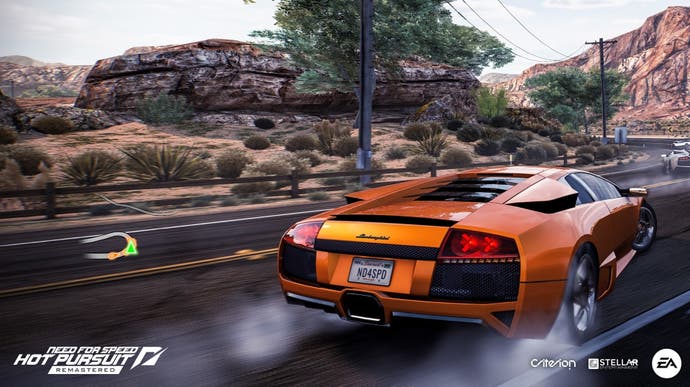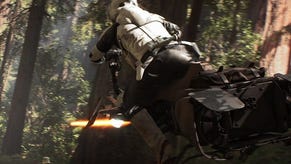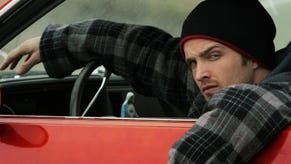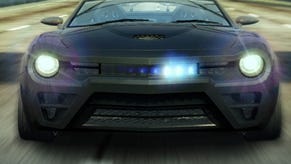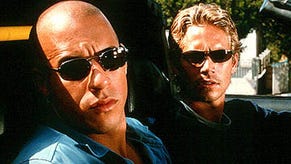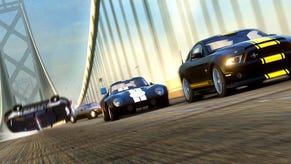Fast cars, big bums and the secrets behind one of the best Need for Speed games yet
Criterion on Hot Pursuit Remastered, and where the series goes next.
It's not so much a secret at this point, but at least we now have the finer details: Need for Speed: Hot Pursuit Remastered is coming later this year, with PC, PS4 and Xbox One getting the refreshed title on November 6th while it'll be coming to Nintendo Switch on November 13th. There's a visual overhaul, with 60fps being the target on PC, PS4 and Xbox One while the Switch is looking to hit 30fps, while they'll all benefit from cross-platform multiplayer (a key part of Hot Pursuit's make-up, seeing how it introduced the concept of asynchronous multiplayer to modern games with its Autolog feature).
There's more besides, with the DLC folded into the main campaign, while some subtle tweaks have been made to gameplay and the front-end has had an overhaul. Most importantly, though, the core driving feels as fresh as it ever has - those pendulous slides are intact, while Seacrest County looks better than ever before. It's also a homecoming of sorts for the series, marking the start of Criterion's second stint behind the wheel of the hugely popular series.
Having spent a few hours with Need for Speed: Hot Pursuit Remastered, I chatted to Matt Webster, VP of Criterion Games, and Chris Roberts - one of the original team on Hot Pursuit who's now at Stellar Entertainment and is working as creative director on the remaster.
I'll start by putting my cards on the table - this is my favourite Need for Speed, probably my favourite Criterion game and quite possibly one of my favourite driving games of all-time. What's its special sauce? What is it that makes this Need for Speed stand out? I've got my own thoughts about that, but what do you think it is that makes it so special?
Matt Webster: We probably need a beer in a pub to properly talk about this! I think it's just really pure. That was the starting point for us. It's just really a pure thing. It all started by asking what does Need for Speed mean to us, and it was exotic cars, epic drives and cops. How do you make the purest possible expression of that? It was coming off the back of Burnout Paradise, and we found ourselves doing cars and simulations differently. We were revering the car, actually. More so than in something like Burnout. We were like 'oh my god, we get to play with real cars!'
And that's why we included stuff like, on the car select, you know we put the marketing tagline for the car at the time because we wanted to just imbue it with the purity of the cars. We were getting pressured to put customization in the game as it's a Need for Speed thing. But the sensibility is pure and, and we're revering in the car, then you know, when that Muricelago rolls off the production line in Sant'Agata, they think it's perfect. So let's just keep it perfect. When I look at it now I actually think crikey, it feels quite small as a game. But it's beautifully formed.
When I played it back in 2010 - I think I say this about a lot of arcade racers, but it seemed truer of this than anything else I've played - it really felt like I was finally playing Out Run 3. You had these beautiful vistas, this simplicity to it and these incredible cars, so it definitely gave me that kind of experience. Was that an inspiration as well, especially when it comes to that simplicity.
Matt Webster: Yeah, I think the other thing that you've got to remember, when we use the arcade term, it doesn't stop you doing the really hard yards when it comes to simulation and stuff like that. I think we were just finding our feet of understanding what heroic driving is - if we think about Need for Speed now, that sensibility probably started there. It's a simulation, and then we layer on these smart assists to make you feel like a hero. The truth is the average driver doesn't think they're an average driver. You're in these cars, you want to feel heroic, and that means drifting around the corner, all four wheels smoking and at really high speeds. We really focussed on that experience.
I think it was around Need for Speed: Hot Pursuit when I learnt basically a lot of arcade racing handling models are as sim-focused underneath as anything else - it's just about what you add on top of it.
Chris Roberts: It's the control you apply on top to make people feel great when they're driving the car. You're simulating just as much but it's a fine balance of how much.
Matt Webster: It was the first time we were using all the real data of the cars. And so we plugged all that data in, and I remember one time - I think it was with one of the Mercedes - and we were like hold on a second, this isn't reaching its top speeds. We worked out that we'd actually input the diameter of the wheels some two millimetres out. And so we made the wheels two millimetres bigger, and the sim started pumping out what the performance should have been. You have to do all those hard yards, that hard simulation stuff, and then you just layer the magic on top.
When it comes to applying that control, could you talk me through that? There's a weight which I think is there in a lot of Criterion games - it's there in Burnout, for sure - but it's really pronounced in Hot Pursuit and the way they break traction. I've got no better way of putting it other than the cars all feel like they've got big bums. It's kind of exaggerated in the third person perspective, but I guess my question is how did you get the bums to feel so big?
Chris Roberts: They're very nice bums! For me, it was always an obsession at Criterion. Certainly when I was on Burnout, and also Need for Speed - it's about how good a drift feels, and how you hold it. Hot Pursuit is almost a perfect marriage because it's quite rural as well. It isn't an urban racing game. It's these epic open roads, like the original Need for Speed. So it allows you that time to spend in a drift, and enjoy it, and get that timing right. I mean, the spiralling road in Oakmont Valley. There's an event called Rocket Science where you drive the Gumpert there, and that that is a handful of a car. But if you can squeeze the speed out of the drift on those spirals, then that's, for me anyway, the perfect expression of speed and drift and control in a driving game. I think Hot Pursuit does it so well. Before I got started, my favourite driving game series was Ridge Racer, and that's a game about rhythm and timing and flow, and I think Hot Pursuit has that, but it has an epicness to it, which is a whole new layer on top. And then when you combine that in with the chasing, as well as the purity of the racing - it's pretty heady stuff.
Matt Webster: There's another reason why the bums feel good! Sorry you didn't say that.
No, but the bums do feel good. It's a fact.
Matt Webster: Well the bums look good, and the drifting feels good for two reasons. One is I think we're actually simulating wheels properly, which is why they feel good, and therefore traction, and how it goes through the chassis from the power train is all really valuable. But also, you don't realise this, but how important the camera and how the camera responds to the input, it's actually everything. I used to laugh at people, because they jump into these games and they go immediately to bump the camera, because all these other racing games that can't do sense of speed have conditioned you to go to bumper camera because you want to feel that you're going fast. But we care about the sense of speed in the third person, because that's actually where you get the feel. And the feel on the sticks is the feel in here. It's all intrinsically linked together. So with real cars and the authenticity of the simulation all starting to come together with those sensibilities that we brought from Burnout of the approachability That's why it feels quite purely formed, because we just spent a lot of time on it.
Chris Roberts: It's one of the great third person camera cameras in a driving game, I remember on Burnout, I used to just stand my monitor with acetate and draw the car at the furthest point of its drift and back, and then you take the best feeling car and try set it all up. Hot Pursuit nailed that.
Having put a fair bit of time into the remaster, it still stands up today. Another thing that stood out to me - I was kind of amazed at what you got away with when it comes to licencing, because you've got all these incredible cars and you're not shy in smashing them together, which I thought would have most manufacturers and licensees wincing. Was that a problem back in the day?
Matt Webster: It was a long conversation. Well, there were a couple of breakthroughs that we had. I remember I had one meeting I had with, I think it was with Jaguar - there was me and a couple of the vehicle guys, there was a representative of Jaguar and a representative from his licence agency. We just started talking about cars, and I remember he turned around and asked some of the other people if they minded leaving the room for a bit, because he just wanted to talk about cars. That's what the relationship was like - we love cars, you love cars, we're gonna revere the car, so don't worry about that. People start understanding that.
You obviously both worked on Burnout Paradise Remastered, but this must have been a different proposition with the number of licences involved. I imagine that must have been a bit of a headache.
Matt Webster: It could it could have been, and had to make a few changes, but that's largely because I think someone didn't exist anymore so we couldn't actually renew the licence. 25 years ago, they'd have been like wait a minute, you make video games - we don't even know what that is. But now it's like we reach an audience that they see is really powerful. So there's a really strong relationship between Electronic Arts and manufacturer partners, we understand each other.
Were you tempted to put more modern cars in this remaster at any point? I'm not criticising that decision, by the way - it's weirdly nostalgic going back to these cars from 2010.
Matt Webster: I think it flashed through my mind at the beginning. And then we passed it out pretty quickly. I think you're right, some of these modern cars that are in the game are classics.
We're fast running out of time so I'm going to have to wrap up. Back in 2010 I remember a lot of the excitement was about Criterion working on Need for Speed for the first time, and now with the series coming back there it almost feels like a homecoming. Is starting that new era off with this a statement of intent? Does it say anything about where you want to take the series next?
Matt Webster: Anything creative is an expression of yourself at that moment in time. And even though this one is back then, it's also of its time now, because of the changes we've made and what Stellar's done visually. You know, it was a pretty incredible engine actually to begin with and what they've been able to add to it is quite amazing. And then doing things like Autolog cross-platform - it's hard, that stuff. And I think there's some principles in there that will always be ours because it's in the DNA of the studio. When we made Need for Speed: Hot Pursuit, I think we made some statements of intent which are probably as relevant today as they were back then.
